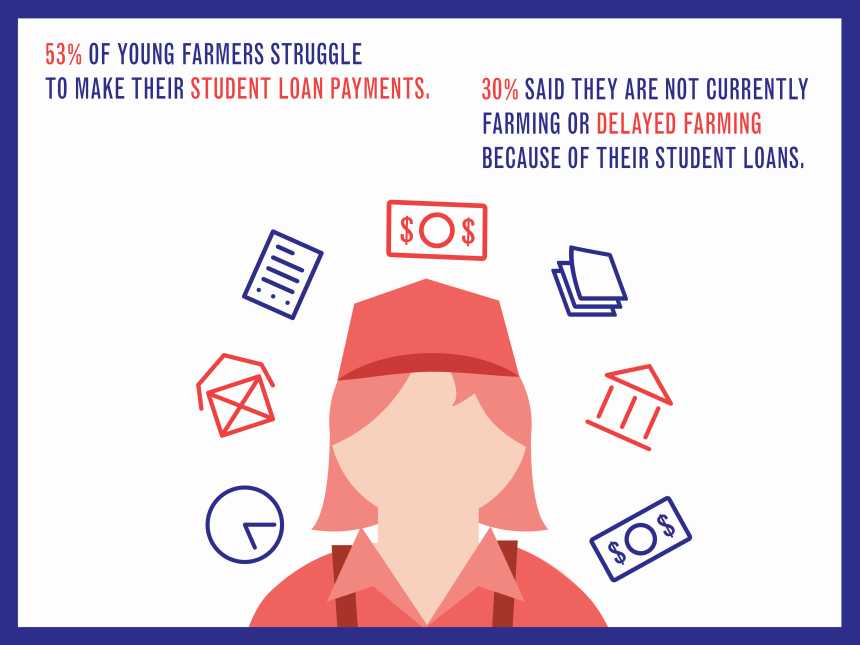Student Loan Debt Depriving U.S. Agriculture Of Future Leaders
One Trillion Dollars. That figure is the total U.S. citizens have in outstanding student loan debt. It’s a tough figure to swallow for anyone of any age.
As troubling as that figure is for the future workforce as a whole, it is more troubling for those hoping to embark on a career in agriculture.

Eric Hansen
Now imagine you’re one of the many young people trying to secure capital for a bright future in farming. Young growers with a significant unsecured debt struggle to secure loans to purchase the equipment they’ll need, or to ride the ebbs and flows of farming income.
“Farming is not the same as it was 30 years ago. It is a much more technically complex industry — people need technological skills, financial management, marketing skills, and business knowledge to succeed in farming,” says Eric Hansen, policy advocate for the National Young Farmers Coalition. “This is a field where it is getting more difficult to succeed in without a college education.”
Biggest Stumbling Blocks For Future Farmers
Hansen’s organization advocates and represents next-generation and first-generation farmers. The group surveyed its members to find out what the biggest challenges are to entering agriculture. One of the largest concerns survey respondents cited was student loan debt.
“Student loans were delaying or preventing 30% of our survey respondents from farming,” he says. “Another 28% said that student loans prevented them from growing their business, and 20% said they were unable to obtain credit because of their student loans.”

Graphic courtesy of the National Young Farms Coalition
Hansen says these figures are definitely troubling to the agriculture industry. Farming is very capital-intensive, and young growers often struggle with the up-front costs of modern growing techniques.
“There are so many fixed assets in the ground that you have to be able to finance getting started,” he says. “It’s particularly challenging dealing with these credit access issues, which is a huge part of the student loan debt story.”
Which is why his organization helped petition for The Young Farmer Success Act. The bill was introduced to the floor this past summer by Reps. Chris Gibson (R-NY) and Joe Courtney (D-CT).
The bill amends the Student Assistance portion of the Higher Education Act of 1965 to include a full-time job as an employee or manager of a farm as a “public service job.” This would make anyone employed by a farm or ranch full-time eligible to apply for the Public Service Employee Loan Forgiveness Program.
“There are some professions for which there is a national interest and a public interest in having people working,” Hansen says. “Those careers are not always lucrative enough to cover someone’s student loan debt coming out of education. This program was meant to address that gap.”
To qualify, the farm needs to have a gross revenue of at least $35,000 in 2015. Debtors would need to make qualifying student loan payments, using an income-based repayment plan for 10 years. If there is still outstanding debt after 10 years, the balance will be forgiven.
What You Can Do
In November, the bill was referred to the House Subcommittee on Higher Education and Workforce Training. In the meantime, Hansen says the most important thing growers of all ages can do is to reach out to your representatives. Make sure they understand this bill is important to you.
“It’s incredibly valuable to invite your member of Congress out to the farm. Show them what you’re doing, what contributions you’re making to your community. You’re providing jobs, you’re producing food, and you’re helping to secure the rural economy,” Hansen says. “Show them the service you’re providing and explain your own struggle with student loan debt.”
He also points out the National Young Farmers Coalition has more resources, including current options for student loan management at FarmingIsPublicService.org. He says his organization hears from growers who are concerned about who will take over their farms as they retire.
“We all have a vested interest in this whether it’s because we are getting started in farming, we are trying to think about what the future is of our farm, or we’re just consumers concerned about where our food is coming from. Are we going to see farmland drop out of production because we don’t have young people to take it over? Are we going to see more consolidation within the farming community?” he says. “As we see more and more consolidation, one of the tradeoffs is losing people in our rural communities. We want to be able to retain young folks who are going to help hold those communities together.”









